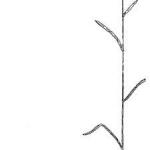Kentucky Bluegrass
Description and Adaptation of Kentucky Bluegrass (Poa pratensis)
Plant Characteristics
Kentucky bluegrass is a long lived sod-forming perennial grass. Stems grow 1 to 2 feet in height when allowed to grow uncut. Leaves are narrow and dark-green 2 to 7 inches in length. The inflorescence is a pyramid-shaped panicle about 2 to 8 inches long. Kentucky bluegrass reproduces by rhizomes as well as by seed. New tillers with their roots, grow from the nodes along the rhizomes, continually filling the spaces left by the death of the older tiller tufts. Each tiller tuft may only survive for two years.
Kentucky bluegrass is a palatable pasture plant making very early growth in the spring. It becomes the dominant grass species, in most of the older pastures. It withstands close and continuous grazing, but becomes nearly dormant in midsummer when daily maximum temperatures approach 90ºF. Growth resumes with the return of cool weather in the fall. Kentucky bluegrass is not a good hay crop.
Adaptation
Kentucky bluegrass is adapted to the humid and subhumid sections of the northern half of the United States. It does best under cool, humid conditions on highly fertile soils not prone to drought. Kentucky Bluegrass grows best on heavier soils with a pH above 6.
In pasture mixtures, bluegrass is generally seeded with other grasses, and clovers. Usually two to three years are required to produce a good sod from seeding. Because of its dense turf, bluegrass is also the most popular lawn grass in America.
Factsheets in this series were prepared by Stephen Herbert, Masoud Hashemi, Carrie Chickering-Sears, and Sarah Weis in collaboration with Ken Miller, Jacqui Carlevale, Katie Campbell-Nelson, and Zack Zenk.
This publication has been funded in part by Mass. Dept. of Agricultural Resources in a grant to the Massachusetts Farm Bureau Federation, Inc. and by Mass. Dept. of Environmental Protection, s319 Program.
